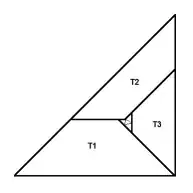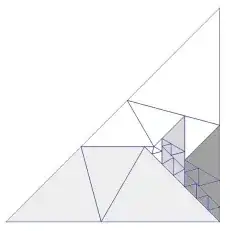How can many different sets of prime-factors fit together so well in this formula?
I am curious about the number of solutions to the following equation:
$$ r_3 = \sqrt{2}\; \frac{ 1 + r_1 (r_2 -\sqrt{2} )} { 2 + \sqrt{3} - r_2 \sqrt{2}\; (1 + \sqrt{3}) + r_1 (2 + \sqrt{3}) (r_2- \sqrt{2}) } \tag {1} $$ where the $r_i$ are of the form $$ r_i = \sqrt{2}\; \frac{a_i-b_i\sqrt{3}} {c_i} \qquad i \in \{1,2,3\} \tag{2} $$ with {a, b, c} $\in$ $\mathbb N$ (positive Integers) and $r_i > \sqrt{2}$ .
This question is closely related to this one, because eq $(1)\,$ has a geometrical interpretation: All solutions with $ r_i > \sqrt{2} \;$ represent possible tilings of a square with similar copies of $\{45°,60°,75°\}$ triangles, and the $r_i$ are the ratios of base to side of trapezoids (formed by the triangles):

There are at least 37 solutions from $(1)$ (which represent unique tilings of a square with less than 100 triangles) like this for example:
$$ \begin{align} & \{\; r_1 = \sqrt{2}\; \frac{6-\sqrt{3}} {3} \;, \qquad \quad r_2 = \sqrt{2}\; \frac{13-3\sqrt{3}} {4} \;, \qquad \; \, r_3 = \sqrt{2}\; \frac{21-2\sqrt{3}} {15} \; \} \; ,\\ & \{\; r_1 = \sqrt{2}\; \frac{213-41\sqrt{3}} {66} \;, \qquad r_2 = \sqrt{2}\; \frac{49-9\sqrt{3}} {46} \;, \qquad \; \; r_3 = \sqrt{2}\; \frac{83-2\sqrt{3}} {46} \; \} \; ,\\ & \{\; r_1 = \sqrt{2}\; \frac{1689-419\sqrt{3}} {624} \;, \qquad r_2 = \sqrt{2}\; \frac{81-14\sqrt{3}} {33} \;, \qquad r_3 = \sqrt{2}\; \frac{170-21\sqrt{3}} {109} \; \} \; ,\\ & \{\; r_1 = \sqrt{2}\; \frac{1524-287\sqrt{3}} {654} \;, \qquad r_2 = \sqrt{2}\; \frac{1701-217\sqrt{3}} {759} \;, \qquad r_3 = \sqrt{2}\; \frac{499-52\sqrt{3}} {359} \; \} \; ,\\ & \dotsb \\ & \{\; r_1 = \sqrt{2}\; \frac{7545-1163\sqrt{3}} {3174} \;, \qquad r_2 = \sqrt{2}\; \frac{5-\sqrt{3}} {2} \;, \qquad r_3 = \sqrt{2}\; \frac{907-122\sqrt{3}} {661} \; \} \qquad \\ \end{align} $$
I don't know if i am completely missing something very basic here, but if the accumulation of many solutions to eq $(1)$ is not happening by pure chance, there has to be a mathematical reason for this.
I would have thought that it is very unlikely that many different prime-factors fit together simultaneously.
$\mathbf{Edit:}$
The only other expression (=trapezoid-setup) among many, for which i found geometrically interpretable solutions (with $r_i > \sqrt{2}$ ) is $ r_3 = \frac{ \sqrt{3}(7 \; r_2 - \sqrt{2} - 5\sqrt{3} \; r_2 + \sqrt{6})+2\sqrt{2} \; r_1 (r_2 + 2\sqrt{2} - \sqrt{6}) } {\sqrt{2} (7r_2 \; + \sqrt {6}- \sqrt{2}\;r_1 ( r_2 (1 + \sqrt{3})-( \sqrt{2}( \sqrt{3}-1) )) ) } \tag {3} $ which again has several valid geometric solutions corresponding to square-tilings with less than 100 triangles, including this one: $ r_1,_2,_3 = \{ \sqrt{2} (7851-1355 \sqrt{3})/3666\;, \sqrt{2} (106-7 \sqrt{3})/65\;, \sqrt{2} (5349 - 709 \sqrt{3})/2442 \} $ representing trapezoids consisting of 15, 13 and 15 triangles respectively.
The simplest solution of $(3)$ looks like this:

So it seems to be the case that although expressions like $(1)$ or $(3)$ have indeed an infinite number of general algebraic solutions, the $r_i>\sqrt2$ condition and other yet unknown requirements seem to allow valid geometric solutions only for a few cases with spezial trapezoid-arrangement and a finite number of solutions.